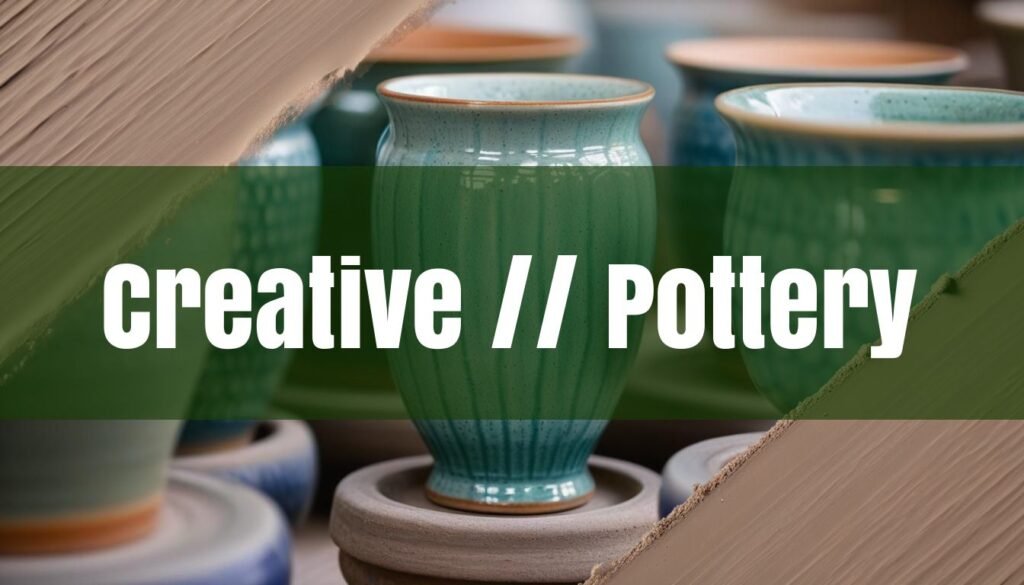Pottery painting is a wonderfully accessible art form, inviting both beginners and seasoned artists to transform simple ceramic pieces into personalized treasures. Whether you’re looking to create a unique gift, add a personal touch to your home decor, or simply unwind with a creative activity, the possibilities are endless. From basic techniques to intricate designs, this guide will walk you through various ideas to paint pottery, ensuring a fun and successful artistic journey. Pottery painting is an enjoyable and relaxing way to express creativity, turning ordinary ceramic pieces into personalized works of art. For more ideas, explore beginner-friendly pottery designs.
Design Ideas and Inspiration
When it comes to design inspiration, the world is your oyster. For beginners, simple patterns like polka dots, stripes, and geometric shapes are excellent starting points. Polka dots are timeless and can instantly add charm to any ceramic piece. You can also find easy ceramic painting ideas to get started. Start by painting your ceramic surface in a base color of your choice. Once dry, use a round sponge or brush to create evenly spaced polka dots using a contrasting color. Experiment with different dot sizes and arrangements for a playful or sophisticated look. Stripes, whether vertical, horizontal, or diagonal, can dramatically change the appearance of your ceramic, making it a standout piece in any setting. For those seeking a more contemporary look, modern minimalist designs using simple lines, monochromatic colors, and negative space can create elegant and understated pieces.
Floral designs are another timeless option, ranging from simple daisies to intricate roses. Bring the beauty of nature indoors with delicate floral patterns. Paint simple flowers, leaves, or vines in a repeating pattern around your ceramic piece. Choose vibrant hues for a lively display or subtle shades for a more understated elegance. Nature-inspired themes, such as landscapes, animals, or botanical illustrations, can be adapted to any piece of pottery. If you prefer a more free-form approach, abstract designs allow for complete freedom of expression. There are no rules with abstract art, so let your imagination run wild. Embrace spontaneity as you paint freeform shapes, swirls, and splatters on your ceramics. For special occasions or personalized gifts, heart patterns, monograms, or favorite quotes can add a thoughtful touch.
For those looking to experiment with different techniques, consider splatter painting for a fun and carefree design or marbling for a mesmerizing effect. Create a mesmerizing marble effect on your ceramics using a marbling technique. Begin by applying a base coat in one color. Then, drip or swirl different colored paints on the surface. Use a toothpick or skewer to gently swirl the colors together for a unique and artistic marble pattern. Marbling can be achieved through various methods, each yielding unique results. Stencils are also a great way to achieve precise and detailed designs, perfect for beginners who want professional-looking results. Achieve a gradient effect with an ombre design on your ceramics. Blend two or more shades of the same color from light to dark (or vice versa) across the surface of your piece. Use a blending brush or sponge to seamlessly transition between colors, creating a subtle and sophisticated appearance that adds depth to your ceramic creations. Animal prints, such as leopard spots, zebra stripes, or cow patterns, can add a fun and wild touch to your pottery. Ultimately, the best design is one that resonates with you and reflects your personal style.
If you are trying to glaze and apply glass to porcelain hydrangeas, this video might be helpful:
Choosing the Right Paints and Techniques
Selecting the right type of paint is crucial for achieving the desired look and ensuring the longevity of your design. Acrylic paints are a popular choice for unglazed pottery due to their versatility, vibrant colors, and non-toxic properties. For more information, check out this guide to ceramic paints. Acrylic paint works well because it’s bright, non-toxic and fast-drying, making it easy to use. These paints have a natural elastic quality which helps them remain intact over time. Once you’ve painted your clay creations, you can finish them using a waterproof sealant. For glazed ceramics, porcelain paint is an excellent option as it adheres better to the slick surface. Porcelain paint tends to apply more evenly to glazed ceramics and can be baked in the oven to seal the colour. Once you’ve painted your design it can be fired in a conventional oven as it has a low firing point, this will ensure the paint sets. Once fired, the paint will be waterproof and washable. Enamel paint is another durable option for glazed pottery, known for its resistance to high temperatures and glossy finish.
When painting, it’s essential to apply thin, even layers to prevent the paint from clumping or running. It is better to apply thinner layers than piling it on. Allow each layer to dry completely before applying the next. If you make a mistake, don’t panic! A damp sponge can be used to gently remove the paint and start again. For intricate designs, consider using paint pens or fine-tipped brushes for greater precision. The easiest thing to paint on pottery is simple designs like dots, lines, or geometric shapes. These patterns don’t require advanced skills and can be done with precision using acrylic paint pens. To add texture, try using sponges, stippling brushes, or even household items like bubble wrap to create unique effects. For those interested in adding more depth, consider sprigging.
Sealing and Caring for Your Painted Pottery
Once your masterpiece is complete, sealing the paint is crucial to protect it from chipping, fading, and moisture. Sealing the paint not only protects it from chipping and fading but also makes your ceramic plate suitable for practical use. For acrylic paint, a water-based polyurethane varnish, clear acrylic coat, or Mod Podge can be used. Apply your chosen sealant in a well-ventilated area, using even strokes to cover the entire painted area. Follow the manufacturer’s instructions for drying times to ensure the best protection. Some sealants may require baking in an oven to cure, so be sure to read the instructions carefully.
For painted flower pots, ensure the entire exterior and interior are sealed with a clear acrylic sealer to prevent moisture from seeping through and ruining the paint job. Terra cotta will soak up moisture, so if you only seal the painted parts, water will still get into the pots from the inside when you water your plants, and it will soak all the way through your pot and ruin your paint job. Let’s try out some different ways to seal terra cotta pots using two sealers that are popular. The two I chose were both clear sealers, Polycrylic Spray and Shellac Spray. Once sealed, your ceramic piece can be gently hand-washed with soft cloths or sponges. Gentle hand washing is recommended over the dishwasher. Over time, you may need to reapply the sealant to maintain its protective layer. With proper sealing and care, your painted pottery will remain a cherished work of art for years to come.





